NCERT Solutions for Class 10 Maths Chapter 13 - Statistics (Exercise 13.1)
Exercise 13.1
Q1. A survey was conducted by a group of students as a part of their environment awareness programme, in which they collected the following data regarding the number of plants in 20 houses in a locality. Find the mean number of plants per house.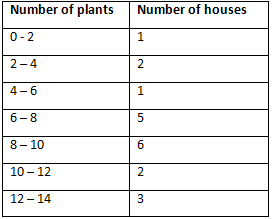
Which method did you use for finding the mean, and why?
Sol. We can calculate the mean as: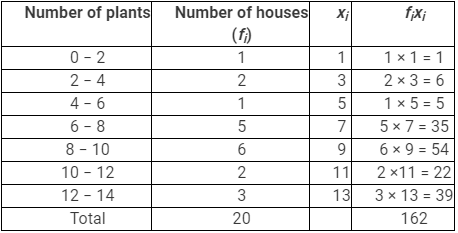

⇒
Thus, the mean number of plants per house is 8.1.
Since values of xi and fi are small
∴ We have used the direct method.
Q2. Consider the following distribution of daily wages of 50 workers of a factory. 
Find the mean daily wages of the workers of the factory by using an appropriate method.
Sol.
To find the class mark for each interval, the following relation is used.
Class size (h) of this data = 20
taking 550 as assured mean (a), di, uj and fiuj can be calculated as follows.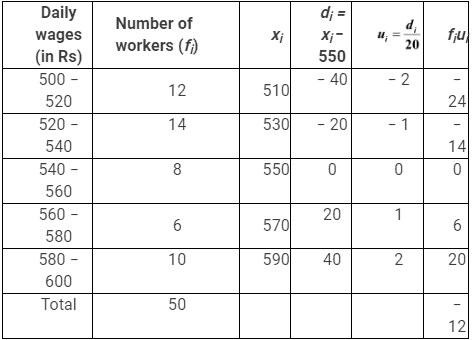
From the table, it can be observed that
 Therefore, the mean daily wage of the workers of the factory is Rs 545.20
Therefore, the mean daily wage of the workers of the factory is Rs 545.20
Q3. The following distribution shows the daily pocket allowance of children of a locality. The mean pocket allowance is Rs 18. Find the missing frequency f.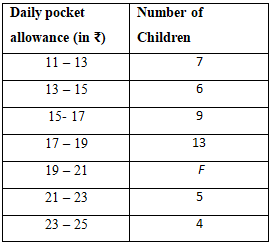
Sol. Let the assumed mean, a = 16
∵ Class interval h = 2
Now, we have the following table: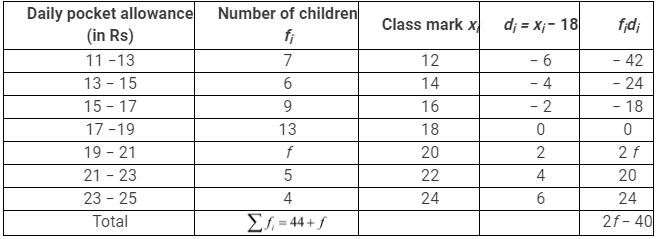
Since
∴ 
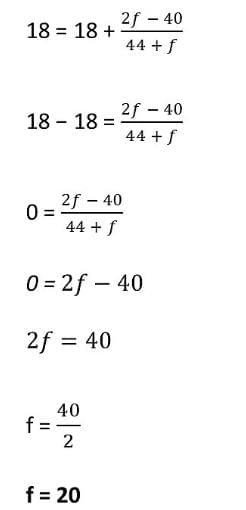
Thus, the missing frequency is 20.
Q4. Thirty women were examined in a hospital by a doctor and the number of heartbeats per minute were recorded and summarised as follows. Find the mean heartbeats per minute for these women, choosing a suitable method.
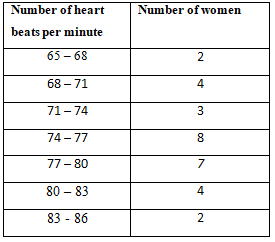
Sol. Let the assumed mean a = 75.5
∴ Class interval h = 3
Now, we have the following table:

Thus, the mean heartbeat per minute is 75.9.
Q5. In a retail market, fruit vendors were selling mangoes kept in packing boxes. These boxes contained varying number of mangoes. The following was the distribution of mangoes according to the number of boxes.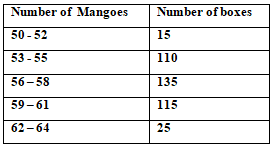
Find the mean number of mangoes kept in a packing box. Which method of finding the mean did you choose?
Sol. Let the assumed mean a = 60
Here, Class interval h = 3
Now, we have the following table:
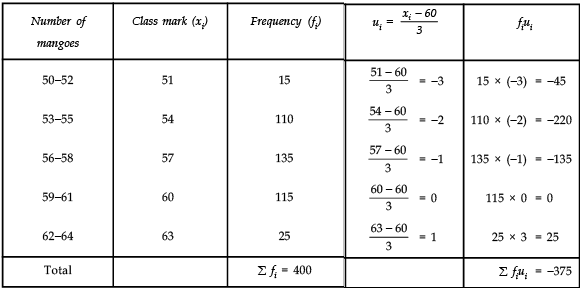
Thus, the average number of mangoes per box = 57.19.
Q6. The table below shows the daily expenditure on food of 25 households in a locality.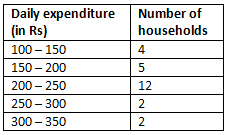
Find the mean daily expenditure on food by a suitable method.
Sol. Let the assumed mean, a = 225
And class interval h = 50
∴ We have the following table:
Thus, the mean daily expenditure of food is Rs 211.
Q7. To find out the concentration of SO2 in the air (in parts per million, i.e., ppm), the data was collected for 30 localities in a certain city and is presented below:
Find the mean concentration of SO2 in the air.
Sol. Let the assumed mean a = 0.14
Here, class interval h = 0.04
∴ We have the following table: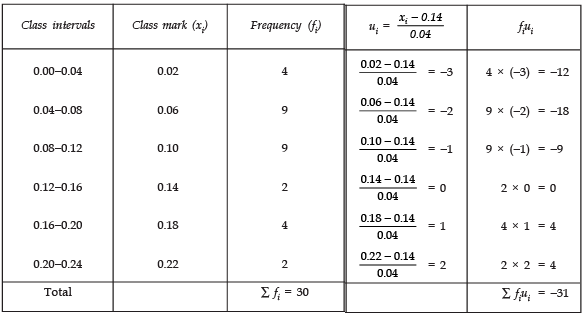
Thus, mean concentration of SO2 in air is 0.099 ppm.
Q8. A class teacher has the following absentee record of 40 students of a class for the whole term. Find the mean number of days a student was absent.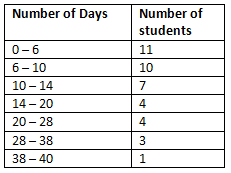
Sol. Using the direct method, we have the following table:
Thus, mean number of days a student remained absent = 12.48 (Approx.)
Q9. The following table gives the literacy rate (in percentage) of 35 cities. Find the mean literacy rate.
Sol. Let assumed mean a =70
∴ Class interval h =10
Now, we have the following table:
Thus, the mean literacy rate is 69.43%.
Exercise 13.2
Q1: The following table shows the ages of the patients admitted in a hospital during a year:
Find the mode and the mean of the data given above. Compare and interpret the two measures of central tendency.
Sol: Mode:
Here, the highest frequency is 23.
The frequency 23 corresponds to the class interval 35 − 45.
∴ The modal class is 35 − 45
Now, Class size (h) = 10
Lower limit (l) = 35 Frequency of the modal class (f1) = 23
Frequency of the class preceding the modal class f0 = 21
Frequency of the class succeeding the modal class f2 = 14
Mean
Let assumed mean a = 40
∵ h = 10

∴ Required mean = 35.37 years.
Q2: The following data gives the information on the observed lifetimes (in hours) of 225 electrical components:
Determine the modal lifetimes of the components.
Sol: Here, the highest frequency = 61.
∵ The frequency 61 corresponds to class 60 − 80
∴ The modal class = 60 − 80
∴ We have: l = 60
h = 20
f1 = 61
f0 = 52
f2 = 38
Thus, the required modal life times of the components are 65.625 hours.
Q3: The following data gives the distribution of total monthly household expenditure of 200 families of a village. Find the modal monthly expenditure of the families. Also, find the mean monthly expenditure:
Sol: Mode:
∵ The maximum number of families 40 have their total monthly expenditure is in interval 1500−2000.
∴ Modal class is 1500−2000.
l = 1500, h = 500
f1 = 40, f0 = 24
f2 = 33
Thus, the required modal monthly expenditure of the families is Rs 1847.83.
Mean: Let assumed mean (a) = 3250
∵ h = 500
∴ We have the following table:
Thus, the mean monthly expenditure = Rs 2662.50.
Q4: The following distribution gives the state-wise teacher-student ratio in higher secondary schools of India. Find the mode and mean of this data. Interpret the two measures.
Sol: Mode:
Since the class 30 − 35 has the greatest frequency and h = 5
l = 30
f1 = 10
f0 = 9
f2 = 3
Mean:
Let the assumed mean (a) = 37.5
Since, h = 5
∴ We have the following table: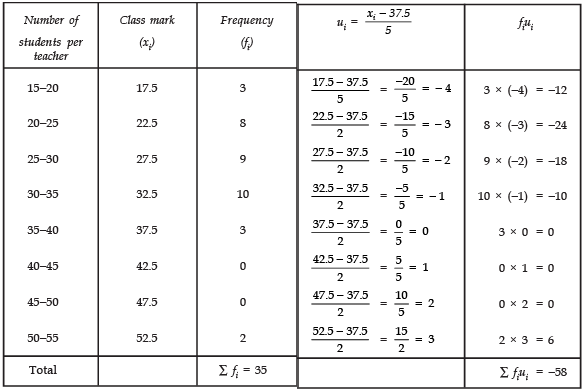
Thus ,the required mean is 29.2
Q5: The given distribution shows the number of runs scored by some top batsmen of the world in one-day international cricket matches.
Find the mode of the data.
Sol: The class 4000−5000 has the highest frequency i.e., 18
∴ h = 1000
l = 4000
f1 = 18
f0 = 4
f2 = 9
Now,
Thus, the required mode is 4608.7.
Q6: A student noted the number of cars passing through a spot on a road for 100 periods each of 3 minutes and summarised it in the table given below. Find the mode of the data:
Sol: ∵ The class 40 − 50 has the maximum frequency i.e., 20
∴ f1 = 20,
f0 = 12,
f2 = 11 and h = 10
Also
l = 40
= 40 + 4.7 = 44.7
Thus, the required mode is 44.7
Exercise 13.3
Q1: The following frequency distribution gives the monthly consumption of electricity of 68 consumers of a locality. Find the median, mean and mode of the data and compare them.
Sol:
Median
Let us prepare a cumulative frequency table:
Now, we have
∵ This observation lies in the class 125−145.
∴ 125−145 is the median class.
∴ l = 125, cf = 22
f = 20 and h = 20
Using the formula,
Mean Assumed mean (a) = 135
∵ Class interval (h) = 20
Now, we have the following table: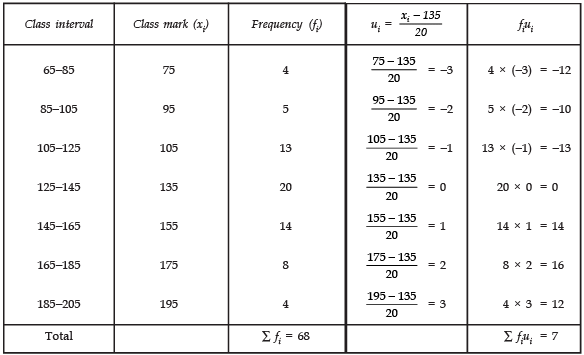
Mode
∵ Class 125−145 has the highest frequency.
∴ This is the modal class.
We have:
h = 20
l = 125
f1 = 20
f0 = 13
f2 = 14
We observe that the three measures are approximately equal in this case.
Q2: If the median of the distribution given below is 28.5, find the values of x and y.
Sol: Here, we have n = 60 [∵ ∑fi = 60]
Now, cumulative frequency table is:
Since, median = 28.5
∴ Median class is 20 − 30
We have: l = 20
h = 10
f = 20
cf = 5 + x
⇒ 57 = 40 + 25 − x
⇒ x = 40 + 25 − 57 = 8
Also 45 + x + y = 60
⇒ 45 + 8 + y = 60
⇒ y = 60 − 45 − 8 = 7
Thus, x = 8
y = 7
Q3: A life insurance agent found the following data for distribution of ages of 100 policy holders. Calculate the median age, if policies are given only to persons having age 18 years on wards but less than 60 years.
Sol: The given table is cumulative frequency distribution. We write the frequency distribution as given below:
∵ The cumulative frequency just greater than n/2 i.e., just greater than 50 is 78.
∴ The median class is 78.
Now n/2 = 50, l = 35, cf = 45, f = 33 and h = 5
Thus, the median age = 35.76 years.
Q4: The lengths of 40 leaves of a plant are measured correct to the nearest millimetre, and the data obtained is represented in the following table:
Find the median length of the leaves.
[Hint: The data needs to be converted to continuous classes for finding the median, since the formula assumes continuous classes. The classes then change to 117.5−126.5, 126.5−135.5, ..., 171.5−180.5]
Sol: After changing the given table as continuous classes we prepare the cumulative frequency table:
∑ fi =40 ⇒ n = 40
Now,
The cumulative frequency just above n/2 i.e., 20 is 29 and it corresponds to the class 144.5−153.5.
So, 144.5−153.5 is the median class.
We have:
n/2 = 20, l = 144.5, f = 12, cf = 17 and h = 9
Q5: The following table gives the distribution of the life time of 400 neon lamps:
Find the median life time of a lamp
Sol: To compute the median, let us write the cumulative frequency distribution as given below:
∑ fi = 400 ⇒ n = 400
Since, the cumulative frequency just greater than n/2 i.e., greater than 200 is 216.
∴ The median class is 3000−3500
∴ l = 3000, cf = 130, f = 86, h = 500 and n/2 = 200
Thus, median life = 3406.98 hours.
Q6: 100 surnames were randomly picked up from a local telephone directory and the frequency distribution of the number of letters in the English alphabets in the surnames was obtained as follows:
Determine the median number of letters in the surnames. Find the mean number of letters in the surnames? Also, find the modal size of the surnames.
Sol: Median
Since, the cumulative frequency just greater than n/2 i.e., greater than 50 is 76.
∴ The class 7 − 10 is the median class,
We have
l = 7
cf = 36
f = 40 and h = 3
Mode
Since the class 7−10 has the maximum frequency.
∴ The modal class is 7−10
So, we have
l = 7, h = 3
f1 = 40,
f0 = 30
f2 = 16
Thus, the required Median = 8.05,
Mean = 8.32 and Mode = 7.88.
Q7: The distribution below gives the weights of 30 students of a class. Find the median weight of the students.
Sol: We have
Weight (in kg) | Frequency (f) | Cumulative frequency |
40-45 | 2 | 2 + 0= 2 |
45-50 | 3 | 2 + 3= 5 |
50-55 | 8 | 5 + 8 = 13 |
55-60 | 6 | 13 + 6 = 19 |
60-65 | 6 | 19 + 6 = 25 |
65-70 | 3 | 25 + 3 = 28 |
70-75 | 2 | 28 + 2 = 30 |
Total | If = 30 | n = 30 |
The cumulative frequency just more than n/2 i.e., more than 15 is 19, which corresponds to the class 55−60.
n/2 = 15.
l = 55
5f = 6
cf = 13 and h = 5
Thus, the required median weight = 56.67 kg.
|
127 videos|584 docs|79 tests
|
FAQs on NCERT Solutions for Class 10 Maths Chapter 13 - Statistics (Exercise 13.1)
| 1. What are the key concepts covered in NCERT Class 10 Statistics Exercises 13.1, 13.2, and 13.3? |  |
| 2. How do you calculate the mean from a frequency distribution in Exercise 13.1? |  |
| 3. What is the significance of the median in statistics as discussed in Exercise 13.2? |  |
| 4. How do you find the mode using the data provided in Exercise 13.3? |  |
| 5. What types of graphs are commonly used to represent data in Class 10 statistics, as mentioned in the exercises? |  |






















